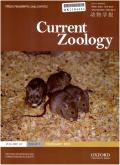Balancing selection shapes population differentiation of MHC genes in wild golden snub-nosed monkeys
IF 2
2区 生物学
Q2 ZOOLOGY
引用次数: 0
Abstract
Abstract Small and isolated populations face several intrinsic risks, such as genetic drift, inbreeding depression, and reduced gene flow. Thus, patterns of genetic diversity and differentiation have become an important focus of conservation genetics research. The golden snub-nosed monkey Rhinopithecus roxellana, an endangered species endemic to China, has experienced rapid reduction in population size and severe population fragmentation over the past few decades. We measured the patterns of genetic diversity and population differentiation using both neutral microsatellites and adaptive major histocompatibility complex (MHC) genes in 2 R. roxellana populations (DPY and GNG) distributed on the northern and southern slopes of the Qinling Mountains, respectively. Eight MHC-linked haplotypes formed by 5 DQA1 alleles, 5 DQB1 alleles, 5 DRB1 alleles, and 4 DRB2 alleles were detected in the 2 populations. The larger GNG population showed higher genetic variation for both MHC and microsatellites than the smaller DPY population, suggesting an effect of genetic drift on genetic variation. Genetic differentiation index (FST) outlier analyses, principal coordinate analysis (PCoA), and inferred population genetic structure showed lower genetic differentiation in the MHC variations than microsatellites, suggesting that pathogen-mediated balancing selection, rather than local adaptation, homogenized the MHC genes of both populations. This study indicates that both balancing selection and genetic drift may shape genetic variation and differentiation in small and fragmented populations.平衡选择决定了野生金丝猴MHC基因的种群分化
小而孤立的种群面临着遗传漂变、近交抑制和基因流减少等内在风险。因此,遗传多样性和分化模式已成为保护遗传学研究的重要焦点。金金丝猴是中国特有的濒危物种,在过去的几十年里,其种群规模迅速减少,种群破碎化严重。利用中性微卫星和适应性主要组织相容性复合体(MHC)基因,对分布在秦岭南、北坡的2个黄颡鱼居群(DPY和GNG)的遗传多样性和群体分化模式进行了研究。在2个群体中检测到5个DQA1等位基因、5个DQB1等位基因、5个DRB1等位基因和4个DRB2等位基因组成的8个mhc连锁单倍型。大GNG群体MHC和微卫星的遗传变异高于小DPY群体,表明遗传漂变对遗传变异有影响。遗传分化指数(FST)异常值分析、主坐标分析(PCoA)和推断的群体遗传结构表明,MHC变异的遗传分化程度低于微卫星,这表明病原体介导的平衡选择,而不是局部适应,使两个群体的MHC基因均质化。该研究表明,平衡选择和遗传漂变都可能在小而分散的种群中形成遗传变异和分化。
本文章由计算机程序翻译,如有差异,请以英文原文为准。
求助全文
约1分钟内获得全文
求助全文
来源期刊

Current Zoology
Agricultural and Biological Sciences-Animal Science and Zoology
CiteScore
3.20
自引率
9.10%
发文量
111
审稿时长
6 weeks
期刊介绍:
About the Journal
Current Zoology (formerly Acta Zoologica Sinica, founded in 1935) is an open access, bimonthly, peer-reviewed international journal of zoology. It publishes review articles and research papers in the fields of ecology, evolution and behaviour.
Current Zoology is sponsored by Institute of Zoology, Chinese Academy of Sciences, along with the China Zoological Society.
 求助内容:
求助内容: 应助结果提醒方式:
应助结果提醒方式:


